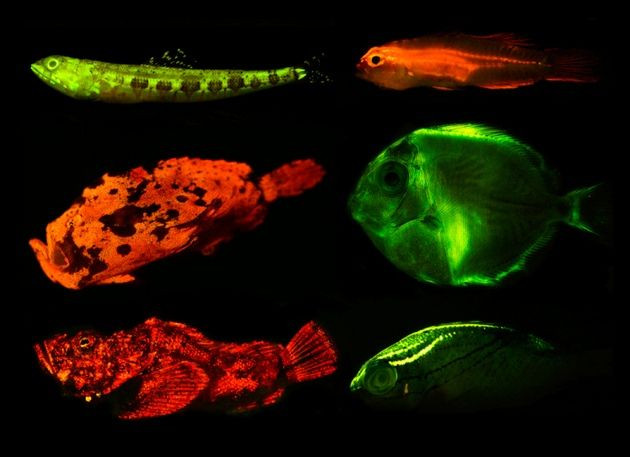Hidden ‘Biofluorescent Universe’ Discovered, 180 Species Of Glowing Fish Caught On Camera [PHOTO, VIDEO]

More than 180 species of fish can glow in shades of neon green, red or orange, a new study suggests.
The findings, published in the journal PLOS ONE, reveal that biofluorescence is much more widespread in the animal kingdom than previously thought. Scientists speculate the underwater light show may be used to help the fish in mating and communication.
"There is a whole light show going on down there," John Sparks, a curator of ichthyology at the American Museum of Natural History in New York and study author, told the Los Angeles Times about the discovery. "There have been studies on corals that are biofluorescent, but for fish, virtually nothing was known."
Their findings came after scientists captured a photo of a glowing green eel while gathering information for a bioluminescence exhibition for the museum. After subsequent underwater expeditions in the Bahamas and Solomon Islands, scientists were surprised to discover that sharks, rays, lizardfish and other species also glowed.
Most of the fish don’t glow under normal light. To capture the biofluorescence, scientists designed specific lighting and cameras that could show them glowing.
“By designing scientific lighting that mimics the ocean’s light along with cameras that can capture the animals’ fluorescent light, we can now catch a glimpse of this hidden biofluorescent universe,” co-lead author David Gruber said in a statement. “Many shallow reef inhabitants and fish have the capabilities to detect fluorescent light and may be using biofluorescence in similar fashions to how animals use bioluminescence, such as to find mates and to camouflage.”
While humans may have a hard time seeing the glow, many fish have yellow filters in their eyes that allow them to see the fluorescent light.
"The cryptically patterned gobies, flatfishes, eels, and scorpionfishes -- these are animals that you'd never normally see during a dive," Sparks said. "To our eyes, they blend right into their environment. But to a fish that has a yellow intraocular filter, they must stick out like a sore thumb."
Biofluorescence is a distinct from bioluminescence, where light is produced by a living organism though a chemical reaction. Some corals, cnidarians, arthropods (like fireflies) and parrots exhibit these qualities. As for the fish in the study, scientists have yet to determine why they glow. Sparks says further research into this question is the next step.
“For now we want to try and get at the functional aspect of it,” he said, adding that scientists will focus on species with diverse patterns to see if the light plays a role in communication.
© Copyright IBTimes 2025. All rights reserved.






















